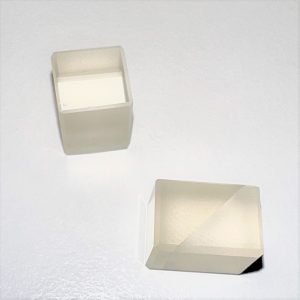Wollaston Prisms separate the unpolarized light into two orthogonally polarized outputs with an angle of separation based on the prism material, typically from 1 to 20 degrees. Currently, two materials in use are Quartz and calcite. Typically, the extinction ratio is more than 10000:1. The crystal quartz and calcite are capable on the wavelength range of 660nm to 1550nm and theoretically from 400nm to 2000nm and 350nm to 2300nm, respectively.


Calcite polarizers are birefringent calcite crystals. Due to the birefringent nature of calcite, waves polarized in the direction of the optical axis propagate with a different index of refraction than waves polarized orthogonally to the optical axis. The birefringence separates the two orthogonal polarization states of an incident beam. A calcite polarizer can be designed as either a polarization splitter/combiner or as a polarizer element that removes the angled, orthogonally polarized component of a beam. Our calcite polarizers are typically built out of two prisms, as shown in the drawing to the right. Since calcite is a soft crystal that is easily damaged, almost all calcite polarizers can be offered in metal housings. With convenient threading and adapters.
Test Note: The crystals were tested at two different wavelength with circularly polarized light and at one wavelength with a polarized light.
|
Crystal Substrate |
Quartz |
Calcite |
|
Extinction Ratio |
>10000:1 |
>10000:1 |
|
Beam Separation angle (Real time) |
1.001º@660nm, 1.002º@1500nm |
20.016º@660nm, 19.472º@1500nm |
|
Coating |
Uncoated |
Uncoated |
When tested both the crystals at polarized single mode 1330nm the intensity ratio of the orthogonal pairs were 10000:1
